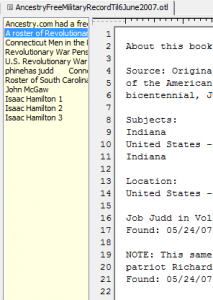The term “brick wall” is used as in many other areas of life, to indicate an obstacle to further progress. In genealogy, this is used to indicate the furthest ancestor of a given branch of your tree you can prove. All efforts to go over, under, around, or through the brick wall have been fruitless. Getting past a brick wall is cause for celebration, especially, if it is one that has existed for twenty or more years.
Likewise, the term “rabbit trail” is used to indicate a diversion from the real goal. It is easy in one’s research to find something interesting and run with it. The next thing you know, you are nowhere near where you had planned to be. Rabbit trails can be very fruitful, but take you away from a planned course of action. Rabbit trails can also end up to be a waste of time. Either way, lack of restraint can lead one off the path of keeping research in order for future review. Chaos in a research intensive activity, makes for more work than keeping it organized from the start.
Here I will share my Brick Walls and Rabbit Trails to both help me in my genealogical quest, and help others learn from my successes and failures.
In genealogy, as with other things in life, the basics must be mastered. Always start with what you know and go from there. It is like the detective shows where they have to piece things together. Genealogy is much the same. One cannot claim to be related to a famous ancestor if there is no proof to tie the intervening generations together. Start with yourself, then your siblings and parents, and work back a generation at a time. All the while, accumulate documentation to support it.
In my case, I have the base of my genealogy from my parents. They did a lot of research and proved a lot of it. However, they did not get it all into a genealogy program, and did not keep it organized as genealogical program standards changed. When I started, I made the mistake of running down the rabbit trail and starting trying to break down the brick wall of the furthest ancestors my parents reached. I spent a few years researching one line in particular, only to learn that the information my parents relied on from another researcher was wrong. I knew better, but still had to learn the hard way. I am now starting at the beginning, and verifying each generation and each person. At the same time, I am cleaning up the data entry my father did. A lot of source information is in the notes, instead of in the sources. This is the way early genealogy programs worked. With nearly 5,000 individuals in their database, it would be a big effort to clean up. However, it is hard to figure out what they found, since a source report will not find what is in the notes. Once again, the slow, methodical approach is needed to make sense out of everything. Only then will I really know what I have. In addition, I now have ten file boxes of the research and correspondence my parents collected. Only a fraction was entered into the database. Back in the days when a ten megabyte hard drive was considered huge, my dad entered enough information into the database, spreadsheets, and documents, to soon fill it.
As will be seen in my continuing efforts, the change in technology in the past twenty plus years, is enormous, and is both a help and a hindrance to moving forward.
As I continue my data clean up and do some online research along the way, I am finding certain self-imposed brick walls of my parents, need to be ignored. For example, one of my great-grandmothers had two older half-sisters. My dad has a note on her in the database that since they never heard from them they must have died. I may have found them on a Kansas State Census with one of their uncles. When taking research from those who have blazed the trail, make sure their “notes on the map” are correct.
I ran across a genealogy tip last week that went something like this: “The easiest brick wall to break down is the one you do not build.” Assumptions must make sense, and stand up to new evidence. Do not swallow the assumptions of other researchers whole hog. Test their assumptions and make sure it fits the available facts.
If what you get from others does not have sources, how can you test it? This is like a text book without footnotes. What good is research without a way for others to verify it? Even the most honest person there is cannot be believed if there are no verifiable facts to back up their claims.
It is better to organize the facts now, so that future family members can trust the work you have done. Without good documentation, they will have to re-do all the legwork you have put in to build your genealogy. Like any other endeavor in life, it is always easier to do it right the first time. Hopefully, I and others can learn from my hard knocks.


